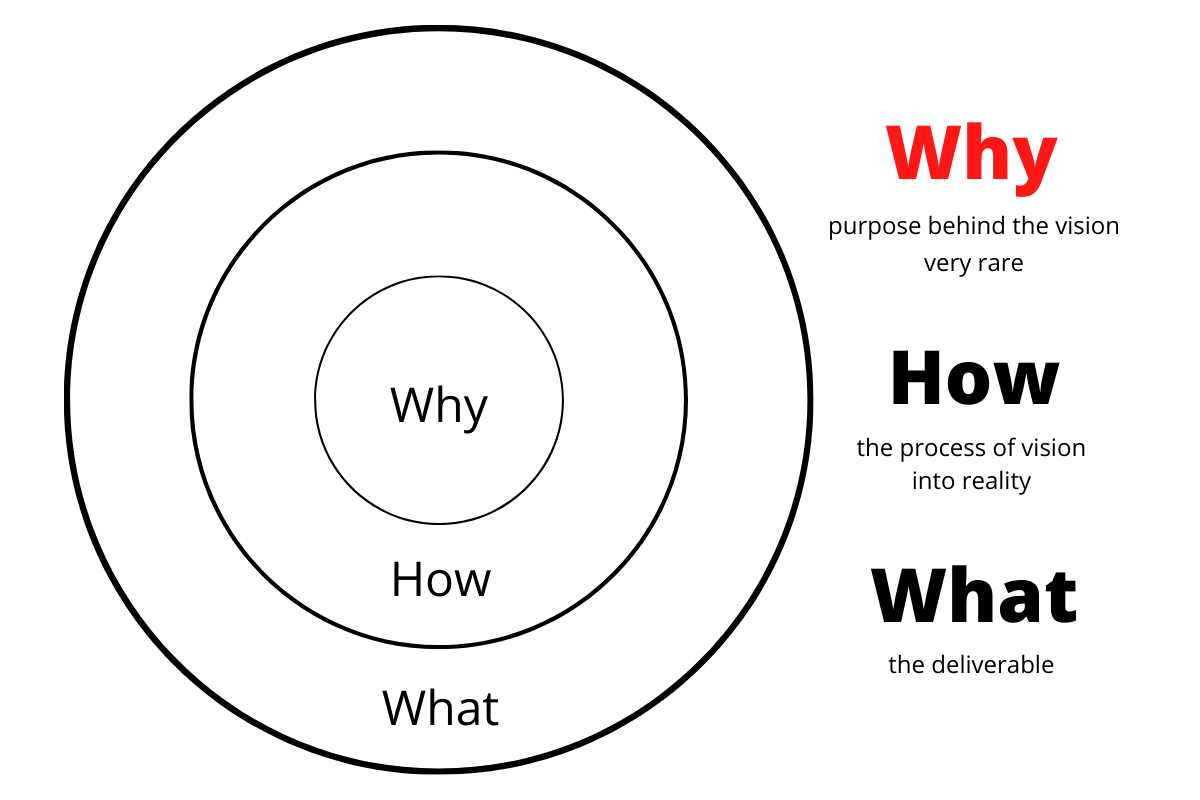How to Sell a Vision: Your “Why” Defines Your Impact
Got an idea for a business?
Do you have an effective plan for bringing that idea to life?
Do you know that there is a definite need for your idea in the marketplace?
Do you have an effective way to measure the results of your idea?
And, are you willing to stake your entire career and life on the idea?
Well, news flash: Ideas don’t matter.
Ideas are cheap.
There are currently more than 32.5 million registered businesses in the United States. Each of them started with an idea, just like the one you have, or don’t have, right now.
Yet, there is only one Apple, one Facebook, one Berkshire Hathaway, and one Amazon.
All 32.5 million of those businesses have ideas, and probably great ideas at that! Not only that, but all of those business leaders are equally capable of creating a generation-defining business. Yet, so few become household names.
Why?
The number one thing that stands in the way of a business from turning their idea into a status quo-disrupting product or service is lack of vision. More specifically, being able to convey the deeper meaning of the vision and sell it to stakeholders.
Ideas do not sell.
Carefully crafted visions that have a deeper significance do sell.
Thankfully, if you have an idea, you can turn it into a contagious vision and market it in three orderly steps:
- Assembling the vision
- Presenting the vision
- Getting your team in on the vision
And, you will be happy to know that you already have almost all of the tools you need to turn your idea into a marketable, pathogenic vision. You only need to put the tools to work!
Right here is the guide that you need to turn your business idea into an inspired vision. And, most importantly, to get stakeholders to buy-in to it.
1. Assembling the Vision With Bigger Thinking
So, you have an idea in mind on how to solve a problem.
Or, perhaps you do not even have an idea yet. But, you do know of a problem.
Considering that problems are the birthplace of every great business, you are in excellent shape!
Real-life problems are everywhere. We all experience them, and this is the great thing about life!
There are so many problems out there just waiting to be solved! In fact, there are more problems out there to be solved than there are great leaders to solve them.
With a problem or idea on how to solve a problem in your mind, take things one large step forward. Ask yourself these dire questions:
- How did this problem come about?
- What direction is the problem taking us?
Take time to really think about your answers. I suggest writing them down.
Think about the implications of your problem on a worldwide scale. Don’t be afraid to go there.
If your answers to these questions do not make you uncomfortable or worried, then stop. Either your problem isn't really a huge deal, or you aren’t thinking big enough about the implications that your problem could have.
The problem you are trying to solve should be able to evoke intense emotion inside of you.
Think beyond the scope of your own little world:
- What will happen to humanity if we do not solve this problem?
- How many lives could we positively change if we do this?
- Will we be able to survive if we do not find a solution?
If you don’t have the ability to paint a bigger vision of your idea or problem, you need to do something else. This problem is not for you to solve.
And, that is okay! Remember, there are a million different problems out there to be solved.
If this isn’t the problem for you to solve, find another one that is! You will know it is for you if thinking about it ignites a certain fire inside of you.
As the founder of the iPhone and driver of the vision behind Apple, Steve Jobs, once said, “If you are working on something exciting that you really care about, you don’t have to be pushed. The vision pulls you.”
However, if you do feel the passion AND can paint a bigger vision of the idea, then it is on you to create a viable business solution for it.
Get real on your idea by putting it into a greater perspective. THINK BIG. If you do this, you have achieved the first step in assembling your marketable vision.
Articulating Your Why: Vision Into Purpose
Once you have identified a problem, come up with an idea to solve it, and have a vision of the solution, you still need to go one step further.
Every business owner and salesperson understands that they make money as a result of doing business. Money is a result, not reason.
However, not every business team member fully understands why they do business to begin with.
Perhaps they are making transactions, yet they don't understand:
- Why they do the work that they do
- Why their business exists in the first place
- Why anyone should care about their business
As a result, they fall short of reaching their full potential. They don't make it into the leagues of being a revolutionary business.
Something is missing.
In his best-selling book Start With Why, Simon Sinek explains what he calls The Golden Circle.
At the very center of the circle is the word "why". He suggests that understanding why a business does what it does is the starting point of everything.
"Why" is synonymous with "purpose".
Moreover, until a business understands its true purpose, it will be limited in the impact it makes.
Until you have a "why", you cannot move on to the "how" or "what".
Sinek gives the example of Apple as a company that has gotten to the core of its why.
People do not purchase an iPhone or MacBook so they can call someone or use the internet. If that is what people were looking for, they would opt for a far less expensive phone or computer.
Instead, people purchase iPhones and MacBooks among other Apple products because they empower them in a way that no other piece of technology does.
Apple’s purpose is to create a feeling of empowerment!
Apple understands this. And, their marketing strategy is to capitalize on this empowering impact.
With that said, how do you come to understand the why behind your vision?
According to Sinek, you need to look inside of yourself to understand the why. Your why is beyond what any market research or data will tell you.
Look inside yourself to see what your emotions and motivations are.
What is pulling on your heart? Why did the problem you first identified tap on your shoulder in the first place?
Your purpose is sure to be an emotional one. Because, at the end of the day, our primary and most satisfying pursuit in life as humans is to fulfill our emotions, not our logic.
If you can identify the emotional call behind your idea, you have identified the true purpose of it.
And, with that "why", you can officially sell the vision meaning.
Visions and Viability: How Logic Gets in the Way
So, you’ve got the idea, the vision, and the purpose behind it. Now what?
CAUTION: This is the point at which most people fall off the rails!
Every single time someone comes up with a new vision, thinks big about it, and has the purpose to back it up, they feel like they are high.
But shortly after, the demon called logic creeps in.
Logic does not deserve the hype that we tend to give it as a society.
When used correctly and in the proper situations, logic enables you to turn your visions into the ultimate business strategy. BUT, we are not quite there yet.
At this point in the game, logic is still a demon. It is going to tell you that your vision is not viable.
Why?
Because logic has never heard of your vision before, or seen it played out in the real world. Logic does not understand visions the way that your imagination does.
Does this inner dialogue sound familiar to you? It does to every great entrepreneur who has ever existed.
The good news is that you know you are on the right track if logic is talking to you in this negative way. If logic is trying to tell you that something is off, it means that you have truly come up with an imaginative, ground-breaking idea.
Logic is excellent when used at the right time and place.
However, you don’t need it at this moment. It will only stand in your way.
Banish any “logical” thoughts in your mind telling you that your vision is not feasible or too big!
If you continue to think of your vision and purpose in as impactful a way as you can, logic and viability will rise up to meet you!

2. How Do You Sell Your Why?
Assembling your vision and purpose behind it is the most challenging piece of the process.
But it isn’t enough to just have the vision. Now you have to sell it! Specifically, you have to sell the purpose behind the vision.
Selling a business product or service comes down to being able to articulate that purpose-driven vision to others!
The way to start doing that is to take your vision and put it into a short and sweet vision statement.
Think of a vision statement like a one-sentence elevator pitch that tells people the "why" behind your vision.
For example, LinkedIn's vision statement is, "To create opportunity for every member of the global workforce."
Why is LinkedIn's vision statement so effective?: Because it gets people excited! Who doesn't want to purchase a product or service that creates more opportunities for workers on a global level?
You can see here that LinkedIn does not reveal what they do. But, they do reveal the purpose of what they do.
Let's imagine that your friend years ago was trying to convince you to invest in LinkedIn's IPO.
They tell you that LinkedIn is a new social media platform for professional networking, finding and posting jobs, and sharing business news.
That description alone evokes no emotion. It is pure logic.
And, there technically already are several other online platforms that enable you to do those same things. So, why would you invest in them?
Had your friend told you about LinkedIn's vision statement, that would have evoked emotion in you. Not only that, but it would have set LinkedIn apart from every other online platform.
Thanks to your friend’s poor explanation, you probably wouldn’t have invested. Years later, you would come to regret that decision!
The most effective vision statements have these three components:
- An explanation of the "why" behind the company
- Inspired language that evokes emotions
- Just enough information to make you want to know more about the actual product or service
For some people, taking a grand vision plan and having to cut it down into a short sentence is very challenging.
If this sounds like you, then a good place to start instead is with the vision script. Then, you can go back and put together the vision statement.
The Vision Script: How to Present a Vision
With a clarified vision solidified in your mind, you are ready to call upon that old demon on your shoulder: logic.
By this point in the process, you are ready to make practical use of logic. Now, it will help you put together the vision script.
But, just be aware that it does not creep back in and try to convince you that you are thinking too big!
What is a vision script?
A vision script is a practical outline of the technicalities of your vision. Essentially, it is a roadmap for turning your vision into a product or service, and what you will deliver to prospects.
A vision script acts as an outline for your formal sales proposals.
Whenever you are putting together a formal presentation for prospects, refer back to your script!
In addition to the vision statement, it generally involves three key components:
- The deliverable: What is the actual application of your vision?
- The marketing: How do you plan on delivering the message of your vision?
- Measurable outcomes: How do you measure the impact of your vision?
To start off, what is the product or service that will help solve the initial problem you encountered? Moreover, what is the deliverable or the “what” that sits outside of your “why”?
Second, how are you going to market your vision? This is the first “how” of your vision.
As you already know, products and services themselves aren’t sold to prospects! Instead, the visions behind them sell, and then the prospect gets the deliverable as a means to fulfill that vision.
How are you going to bring life to that vision through your marketing strategy?
Lastly, the second “how” is how are you going to measure the impact of your vision? What is your “why” trying to accomplish?
For example, Tesla’s vision statement is “create the most compelling car company of the 21st century by driving the world's transition to electric vehicles”.
For Tesla, they could measure whether or not they accomplished their vision by different metrics, such as the rate at which electric car purchases begin to outpace traditional car purchases.
Moreover, your vision must make some type of measurable impact. If it can’t be measured, then the vision doesn’t solve the problem.
The vision script is the first large step forward in turning your vision into physical reality. It is the starting point for presenting your vision to all the right prospects.
Sell Your Vision to The Right Prospects (Learn to Love No)
In any occasion, qualifying your prospects is one of the most crucial steps of the sales process.
But, when you are zoned in on selling your vision, qualifying becomes even more important!
Why?
Because, not every prospect, or person in general for that matter, is going to believe in the purpose of your vision.
Not everyone is prepared for such disruption in their life.
And, that is okay! In fact, getting people to say no to you because they don’t believe in your vision does two things for you:
- It gives you an even better idea of your ideal prospect
- It proves that you’re thinking differently
First off, when a prospect voices that they don’t believe in your vision, you can be sure that they are not right for you! They are not ready to think as big as you are.
As a result, you don’t make the sale, but you have a better idea of the type of prospect that you don’t want to sell to.
Second, when you’ve cemented your vision and somebody turns you down, that could be verification that you are thinking in a revolutionary way.
Remember, disruption in the market should make people feel uncomfortable at first. New ideas are usually met with a heavy amount of skepticism.
If people are turning down your vision, this verifies that you are on the path to something never seen before.
Even if your vision needs some refinement, at least you know you are being disruptive!
You could lose prospects in the short-term. But, in the long term, those same prospects will wish that they had said yes to you earlier on.

3. How Do You Sell Vision To a Team?
No life-changing vision can manifest with your effort alone.
Any killer idea needs an even more killer sales team!
But, one of the biggest challenges business leaders face is getting their sales team in on the “why” behind the vision.
While your team may have the vision down, they may not have the same enthusiasm over the purpose of it as you do.
If you find yourself in a position where your team isn’t shelling out the enthusiasm, first check yourself on whether or not you are using the right employee motivational tactics.
After that, spend time investing in your team’s enthusiasm.
You need to literally get your team in on the vision. It isn’t enough for them to understand it. They have to believe in the “why” just as much, if not more than you!
To do that, go through these ideas with your team:
- Reflect back on the “how we got here and where we are headed”
- Talk about what you all want to be remembered for
- Brainstorm what your future as a company could look like if things go right
Not only should you get your sales team in on the vision, but you should ask them to help refine the vision. When your team feels like they have a stake in the business success, their enthusiasm will boost!
One person alone can’t turn an idea into a revolutionary business.
Invest in your team, and you invest in your impact!
The Bottom Line: Your “Why” Defines Your Impact
Whether you are just starting to manifest your vision or are returning to the drawing board, your vision and the purpose behind it is the single most important factor in your business growth.
Having an idea is not enough.
You have to have an inspired vision that is powered by a deeper purpose. Until you get that down, you will have a low hanging ceiling over your head.
Once you get that vision down, it’s only a matter of getting it out in front of your prospects.
Want to take things to the next level with even bigger visions? Start by getting inspired from some of the world’s most successful entrepreneurs.
All great entrepreneurs are great visionaries. Yet, not all great visionaries are great entrepreneurs.Find out what sets entrepreneurs apart from the crowd of visionaries, and what they do to turn their visions into reality.
You May Also Like
These Related Articles

9 Business Leadership Truths That Entrepreneurs Live By

7 Business Leadership Qualities of Effective Leaders




